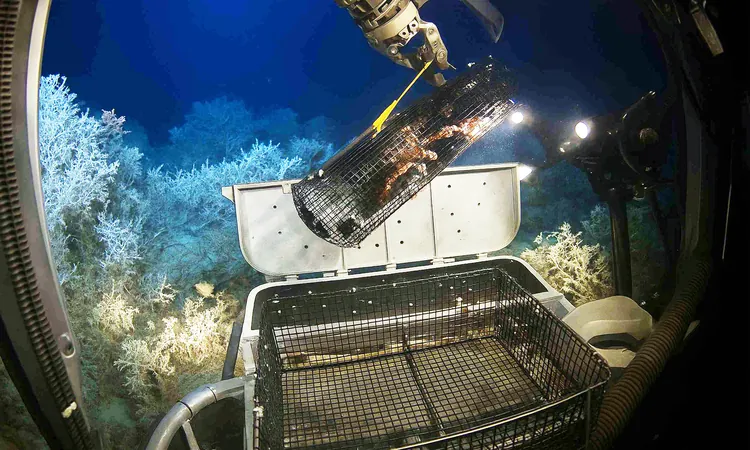
Scientists Discover Surprising Radioactive Beryllium Buildup in Pacific Ocean
2025-07-17
Author: Ken Lee
Radioactive Mystery in the Depths of the Ocean
In a shocking revelation, scientists conducting research nearly three miles beneath the surface of the Central Pacific Ocean stumbled upon an unexpected layer rich in the radioactive isotope beryllium-10 (10Be). Contrary to their predictions of straightforward chemical patterns, the team unearthed a dense band of 10Be dating back around 10 million years, boosting normal background levels by a staggering 73%!
A Team of Experts
The study was spearheaded by Dr. Dominik Koll from the Australian National University, collaborating with the Helmholtz-Zentrum Dresden-Rossendorf. Their meticulous investigation involved scraping sediment from the ocean floor and utilizing accelerator mass spectrometry to analyze the samples.
How 10Be Enters the Ocean
So how does 10Be end up in our oceans? This long-lived radionuclide originates high in the Earth's atmosphere when cosmic rays collide with nitrogen and oxygen. These new isotopes remain suspended in aerosols for about one to two years before being deposited into the ocean through rain or snow, mixing with stable beryllium-9 carried by rivers from eroding rocks.
A Clue to Earth's History
10Be is a valuable tool for geologists; due to its slow decay, it allows scientists to date marine sediments and ice cores over millions of years. Typically, as sediment layers form, 10Be levels steadily decline with depth. However, any spike indicates an accelerated supply or a slowed loss.
Unique Geological Findings
Dr. Koll noted that the ferromanganese crusts lining the ocean floor act as pristine geological records of environmental changes over millions of years. The cores extracted illustrated a remarkable rise in 10Be concentration around 10.1 million years ago, persisting for at least 1.4 million years and enhancing the ocean's beryllium store by 25%.
Understanding the Miocene Climate Shift
This discovery corresponds with a period known as the Late Miocene, a time when the Antarctic Circumpolar Current (ACC) intensified. Researchers speculate that changes in these currents could have transported nutrient-rich water loaded with 10Be into the central Pacific, flooding the area for centuries.
Cosmic Influences?
There are theories regarding cosmic events that might have contributed to this spike in 10Be accumulation. Suggestions include a temporary dip in Earth's magnetic field, allowing more cosmic rays to penetrate the atmosphere, or even a dense interstellar cloud that altered solar radiation exposure.
What Lies Ahead
Research teams are now focused on examining low-sedimentation areas of the South Pacific to gather more precise data. If future findings reveal a pronounced peak in 10Be, it could signify a cosmic origin, while broader trends might support an oceanic-driven explanation.
The implications of these investigations are profound. If corroborated globally, this radioactive layer could serve as a pivotal marker for first responders studying Earth's climatic transitions.
A Cosmic Diary Underwater
In essence, this thin ribbon of beryllium in the Pacific Ocean serves as a fascinating reminder that the ocean floor is not merely a silent witness to geological processes but a cosmic ledger filled with radioactive secrets.
The findings are detailed in the latest issue of Nature Communications, marking a significant leap in our understanding of both oceanography and Earth's historical climate shifts.


 Brasil (PT)
Brasil (PT)
 Canada (EN)
Canada (EN)
 Chile (ES)
Chile (ES)
 Česko (CS)
Česko (CS)
 대한민국 (KO)
대한민국 (KO)
 España (ES)
España (ES)
 France (FR)
France (FR)
 Hong Kong (EN)
Hong Kong (EN)
 Italia (IT)
Italia (IT)
 日本 (JA)
日本 (JA)
 Magyarország (HU)
Magyarország (HU)
 Norge (NO)
Norge (NO)
 Polska (PL)
Polska (PL)
 Schweiz (DE)
Schweiz (DE)
 Singapore (EN)
Singapore (EN)
 Sverige (SV)
Sverige (SV)
 Suomi (FI)
Suomi (FI)
 Türkiye (TR)
Türkiye (TR)
 الإمارات العربية المتحدة (AR)
الإمارات العربية المتحدة (AR)